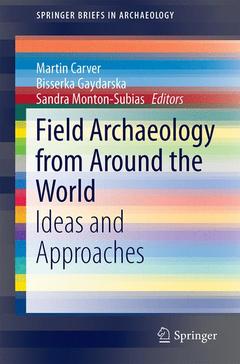Description
Field Archaeology from Around the World, 2015
Ideas and Approaches
SpringerBriefs in Archaeology Series
Coordinators: Carver Martin, Gaydarska Bisserka, Montón-Subías Sandra
Language: English
Subject for Field Archaeology from Around the World:
245 p. · 15.5x23.5 cm · Paperback
Description
/li>Contents
/li>Biography
/li>Comment
/li>
Field practice in archaeology varies greatly throughout the world, mainly because archaeological sites survive in very different ways in different counties. Many manuals see this as a problem - to be defeated by the imposition of standardised procedures. In this book we relish the variety of field practice, seeing it rather as the way the best archaeologists have responded creatively to the challenges of terrain, research objectives and the communities within which they work. While insisting on the highest levels of investigation, we celebrate the different designs, concepts, scientific detection methods and recording systems applied - so embracing standards, but not standardisation. The book is organised in four parts:
Part 1 offers a summary of field procedures.
Part 2 reviews the principal methods applied, above and below ground, and how the results are analysed.
Part 3 illustrates the huge variety confronted by field workers with a series of exemplary commercial and academic projects enacted in downland, jungle, desert, permafrost, road schemes and towns. Approaches also differ according to the traditional methodologies that have evolved in particular countries.
In Part 4 we give examples of some the strongest and oldest of those practised on four continents. ?
Part 1: Methods.- Chapter 1: Field Method in Archaeology: Overview.- Chapter 2: Natural and Cultural Formation Processes.- Chapter 3: Aerial archaeology.- Chapter 4: Surface Survey: Method and Strategies.- Chapter 5: Non-destructive Subsurface Mapping.- Chapter 6: Excavation methods.- Chapter 7: The Archaeological Study of Buildings.- Chapter 8: Recording Fieldwork.- Chapter 9: Spatial analysis.- Chapter 10: Sequence and Date.- Chapter 11: Ethno-archaeology: approaches to fieldwork.- Chapter 12: Publication.- Part 2: Projects.- Chapter 13: Large scale landscape mapping in Yorkshire, England.- Chapter 14: Seascape Survey on the Inner Ionian archipelago.- Chapter 15: Archaeology in advance of motorway construction in Ireland.- Chapter 16: Digging through permafrost in Siberia.- Chapter 17: A tropical rainforest site in Belize Cynthia Robin.- Chapter 18: Excavating a Rock shelter in north-west Greece Nena Galanidou.- Chapter 19: Excavation and survey at Pinnacle Point, S Africa.- Chapter 20: An upper Paleolithic living floor at Monruz, Switzerland.- Chapter 21: On the beach in Remote Oceania.- Chapter 22: Defining the Neolithic on the German loess.- Chapter 23: Crannóg investigations in Scotland.- Chapter 24: Investigating Tells in Syria.- Chapter 25: Terp excavation in the Netherlands.- Chapter 26: A terramare site on the Po Plain, Italy.- Chapter 27: Hillfort investigations in the Czech Republic.- Chapter 28: Excavating burials in Anglo-Saxon England.- Chapter 29: A Burial mound dissection in Sweden.- Chapter 30: Down a mine at Gavá, Spain.- Chapter 31: Urban archaeology at Five Points New York City.- Chapter 32: After the earthquake in Bam, Iran; archaeological and social investigations.- Chapter 33: Ethnoarchaeology in the field: Learning from potters in Gilund, India.- Part 3: Traditions.- Chapter 34: America.- Chapter 35: Poland.- Chapter 36: Britain.- Chapter 37: Scandinavia.- Chapter 38: France.- Chapter 39: China.- Chapter 40: Japan.- Chapter41: Australia.
Martin Carver is emeritus Professor of Archaeology at the University of York (UK) and Editor of Antiquity. He is the founder of two commercial archaeology companies (FAS-Heritage and Birmingham Archaeology) and two museums (Sutton Hoo and the Tarbat Discovery Centre). He was secretary of the Institute of Field Archaeologists at its foundation and has carried out field research in England, Scotland, France, Italy and Algeria. His research interests are Field Method and the archaeology of protohistoric Europe.
Bisserka Gaydarska is a Post Doctoral Research Assistant at the Department of Archaeology in Durham University. After graduating from Sofia University, she received her PhD in Durham University, which has been fostering her research activities ever since. Apart from her homeland Bulgaria, Bisserka has been involved in various field projects and museum studies in Romania, Greece, Turkey and recently Ukraine. Her main research interests are in landscape archaeology, material culture studies, the archaeology of gender and interdisciplinary studies that combine archeological science or information technology with archaeology.
Sandra Montón-Subías is ICREA Research Professor at UPF (Universitat Pompeu Fabra), Barcelona, Spain. She is interested in broad issues in social and theoretical archaeology, including conflict, gender, identity and funerary practice. More recently, she has added historical archaeology and the archaeology of Modern Spanish colonialism to her research agenda She is co-chair of the EAA working party Archaeology and Gender in Europe.




